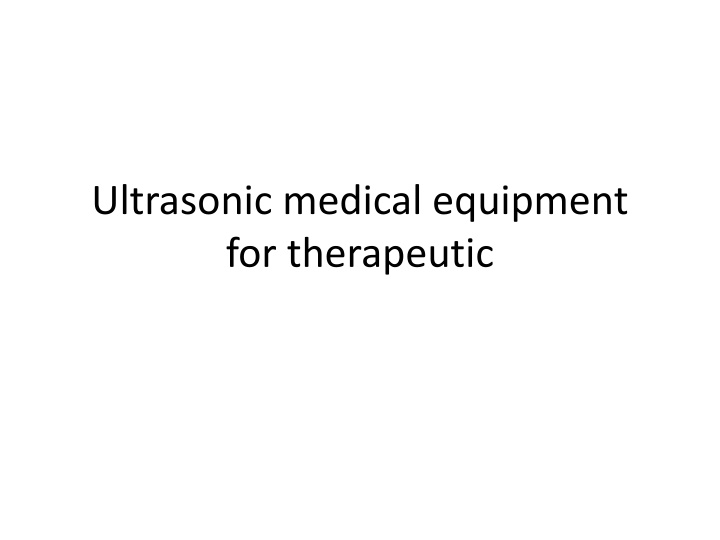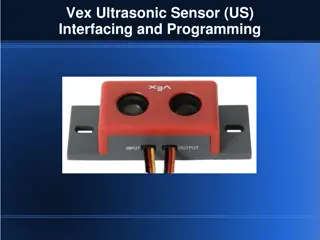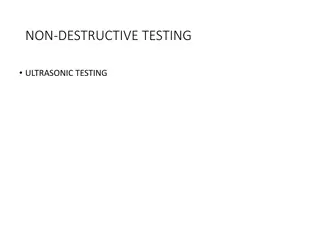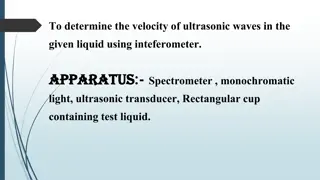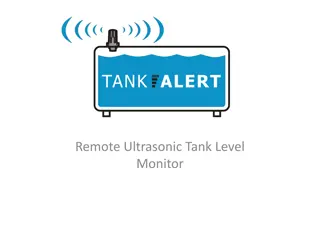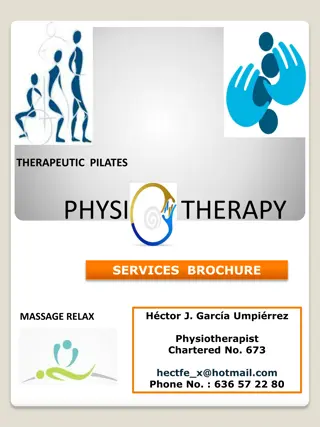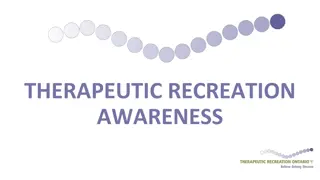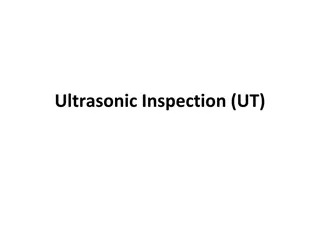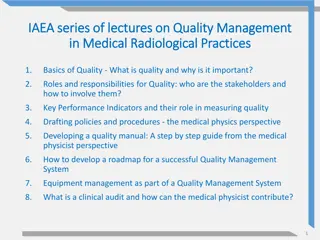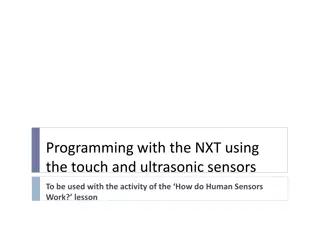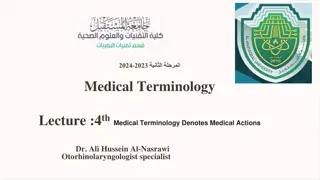Ultrasonic Medical Equipment for Therapeutic Purposes
Ultrasonic medical equipment is explored for therapeutic benefits, focusing on the impact of different intensities on tissues and organs. The use of ultrasound waves and their effects on the body, including changes in heart rate, blood pressure, and organ function, are examined. Different types of ultrasonic waves and their varying intensities are discussed in relation to potential therapeutic applications and associated risks.
Download Presentation

Please find below an Image/Link to download the presentation.
The content on the website is provided AS IS for your information and personal use only. It may not be sold, licensed, or shared on other websites without obtaining consent from the author.If you encounter any issues during the download, it is possible that the publisher has removed the file from their server.
You are allowed to download the files provided on this website for personal or commercial use, subject to the condition that they are used lawfully. All files are the property of their respective owners.
The content on the website is provided AS IS for your information and personal use only. It may not be sold, licensed, or shared on other websites without obtaining consent from the author.
E N D
Presentation Transcript
Ultrasonic medical equipment for therapeutic
HISTORY Most of the studies conducted in the beginning of the century, dedicated to his "destructive" effect. The destructive effect of the ultrasound is only indirectly related to the mechanism of its therapeutic action, because the magnitude of ultrasonic treatments is very far from damaging doses of this factor. However, the analysis of the experimental data obtained in studying the effect of high intensity ultrasound is of great interest and may to some extent characterize the mechanism of its therapeutic action.
Ultrasonic for therapeutic It is known that the elastic wave acts on the tissues and the elastic wave causes their biological changes. Interest in the study of this problem is due to the possible risk of the use of the ultrasonic diagnostic systems for imaging, and the ability to induce changes in tissues for therapeutic effect. Effect of ultrasound on the body depends on the power of ultrasonic vibrations, their frequency, duration, method of radiation of ultrasonic energy (continuous, pulsed), tissue sensitivity, intensity, vascularity and the state of metabolism in the tissues. The ultrasonic wave affects the physico-chemical and biological processes that occur in these tissues. The most sensitive to contact high- frequency ultrasound are the autonomic and peripheral nervous system.
Ultrasonic for therapeutic ULTRASONIC WAVES THERE ARE THREE TYPES, WHICH DIFFER IN THE INTENSITY: 1. Low-intensity ultrasound (1.5 W/sm2). 2. The average ultrasound intensity (1.5 3 W/sm2). 3. Ultrasound of high intensity (> 3 W/sm2).
Ultrasonic for therapeutic Your heart rate increases during the ultrasound, changes ECG. The increase of ultrasound intensity leads to arrhythmia, and in some cases cardiac arrest (in experimental animals). The same reactions are observed in people: you experience discomfort when dubbing the thorax, subsequently developed tachycardia and angina. High-frequency and low-intensity ultrasound (0.2 to 1 W/sm2) induces a vasodilator effect, high intensity (> 3 W/sm2) is a vasoconstrictor and the arteries tone is change. Low-intensity ultrasound provides (makes) hypotensive effect, in the increase of its intensity occurs (makes) hypertension.
Ultrasonic for therapeutic Changes in the kidneys, liver, reproductive organs, endocrine glands occur as a result of ultrasound effect on the hypothalamus, which regulates the activity of internal organs reflex and neurohumoral pathways. There is a change in the morphological composition of the blood; the number of erythrocytes and leukocytes are decrease.
Ultrasonic for therapeutic The propagation of ultrasound occurs by periodic compression and rarefaction of the medium. At ultrasound frequency of 1 MHz and intensity of 1 W/sm2, the amplitude of displacement in biological fluids about 0,02 microns. Under these conditions, each cell of size 5 microns (for example, erythrocytes) deforms about 5 nano. This deformation coincides with the threshold offsets that cause the appearance of pulsed bioelectrical activity o It is experimentally shown that ultrasound causes stimulation of the isolated mechanoreceptors pacinian corpuscles (corpuscula lamellosa [NA]) at an amplitude variable displacement 20 nanometers and tactile sensations on the hand of a man at 100 nm (8... 10 W/sm2 to 0.5 MHz). From these values it follows that the ultrasonic wave (1 W/sm2, 1 MHz) can have a noticeable effect, at least on specialized cells mechanoreceptors. The amplitude of the shear acting on the cage will be approximately 10 N/m2. This value is much smaller than the magnitude of the effort required for destruction of cells.
Ultrasonic for therapeutic Erythrocytes, for example, are destroyed by the shear effort more 40 N/m2. However, a less sturdy structures are destroyed with less effort. So, thixotropic phenomena in the cell reversible changes in viscosity in the destruction of gel structure - is observed at the ultrasonic intensity about 0.04 W/sm2. The results of the calculations shows that the intensity of the ultrasound used in physical therapy, only displacement and shear arising because of the velocity gradient, can have a immediate effect on the cell. However, in some circumstances, even weak radiation forces are able to determine certain biological effects, such as the formation of blood clots in the frog and chick embryo.
Ultrasonic for therapeutic The intensities interval of ultrasound used in veterinary and biomedical practice is very wide. The generally accepted interval of intensities of ultrasound used in physiotherapy: 0,05... 1 W/sm2, at least up to 2...3 W/sm2. In exceptional cases, for example, in the treatment of disease Miniera or sterilization animals, increase the intensity to 10 W/sm2. At intensities below 0.05 W/sm2 ultrasound practically ineffective for the treatment, and at intensities in excess of 1W/sm2, can cause undesirable effects such as the suppression of physiological functions of the body, overheating of the tissues, destruction of cells and cellular organelles.
PHYSICAL THERAPY Ultrasound is widely used in physiotherapy practice. Initially, he was considered one of the ways thermal effects, competing with microwave and radio frequency radiation. The main area of ultrasonic therapy application is treatment of soft tissue lesions, joints and bones. However, it is still unknown what the ultrasound intensity is most effective in the treatment of, for example, which of the intensities: SATA or SATP plays a more important role (see Chapter 1). Intuitively, it appears that thermal effects depend on the total energy, i.e. the intensity of SATA, while for non-thermal effects are more important the peak intensity, i.e., SATP. averaged over time and space (SATA) maximum time- averaged space (SATP)
Medical application of ultrasound Ultrasound therapy is the application for therapeutic purposes mechanical vibrations of high frequency (from 20 to 3000 kHz).
Equipment and methods Is commercially available a large variety of ultrasonic medical devices. They are light weight and portable. Many of these devices use ultrasound intensity less 3 W/sm2 and the frequency range of 0.75 5 MHz and continuous or pulsed modes. The pulse modes are selected if you want to use non-thermal effects. The choice of frequency is determined by the depth location of the object: higher frequencies are used to influence the surface area. Mass- produced generators usually have two or three fixed operating frequency and can to change smoothly or discretely to the intensity. Ultrasound in physiotherapy is used mainly in the treatment of soft tissue injuries, to accelerate wound healing, resorption of edema, softening of scars. It is also used for bone disease and circulatory disorders.
the use of therapeutic ultrasound in gynecology In gynecology used transvaginal and abdominal techniques. This technique use small doses of ultrasound. -
the use of therapeutic ultrasound in otorhinolaryngology the low intensity ultrasound has analgesic, desensitizing and anti- inflammatory effect , so it is used in diseases of the ear, nose and throat. Device -3 . The frequency of ultrasonic vibrations 880 kHz, intensity is regulated by the steps of 0,2; 0,4; 0,6; 0,8 W/sm2, working in continuous and pulsed modes, with a pulse duration of 10 MS.
the use of therapeutic ultrasound in otorhinolaryngology Tonsillor-MM is a device allowing for various types of treatments to the following organs: nose, ear, larynx, pharynx. The process occurs due to the ultrasonic effects on damaged human tissue at low frequencies and vacuum. Contact as possible with the dissolved drug by a direct interaction. The device is very easy to carry and can be used in any environment, inpatient or outpatient. When conservative treatment with Tonsillar-MM effect increases almost two times compared to classical methods. According to statistics, the patients with chronic tonsillitis 4 times less resort to operating to remove the tonsils, due to the use of the device. It is recorded that 59% of people diagnosed with compensated form of chronic tonsillitis and 21% with a diagnosis of decompensated form of tonsillitis is almost completely recovered. This method of treatment is ideal for patients with physical pathology and in case of contraindications to anesthesia and surgical removal of the tonsils. The device was created in Russia (not like him), owns the patents of the Russian Federation and relevant evidence for the development in the USSR.
